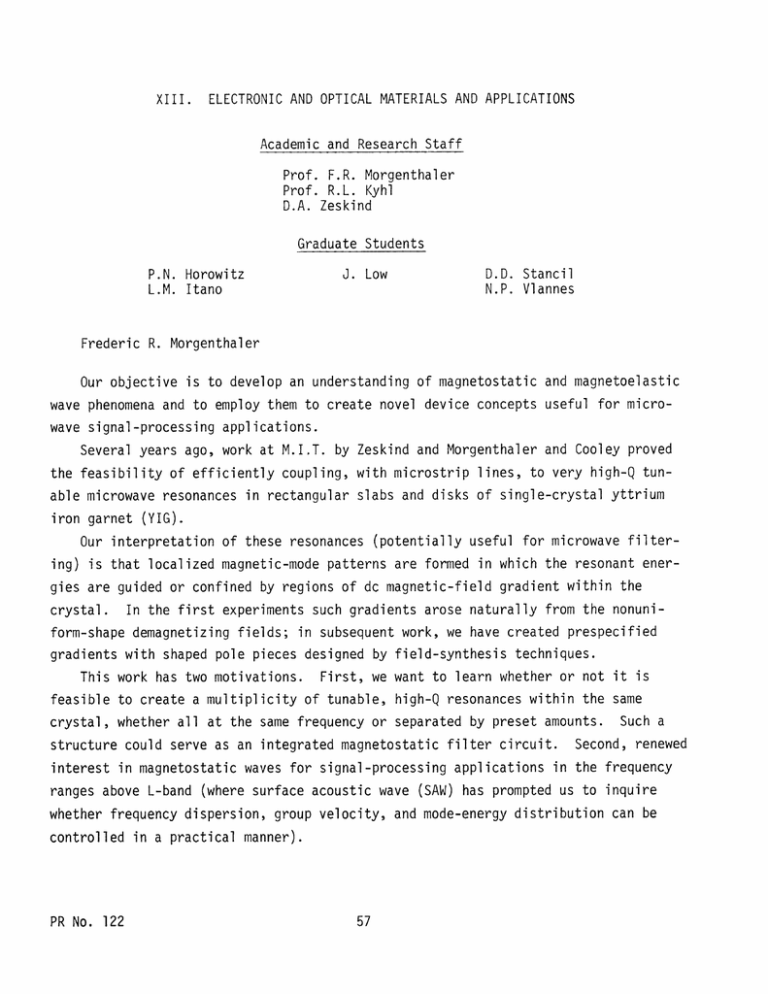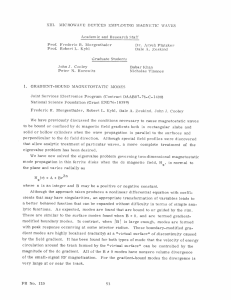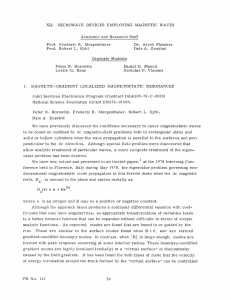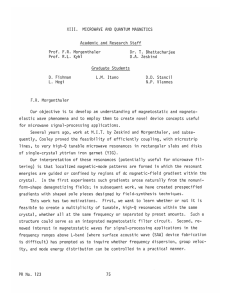XIII. ELECTRONIC AND OPTICAL MATERIALS AND APPLICATIONS
advertisement

XIII. ELECTRONIC AND OPTICAL MATERIALS AND APPLICATIONS Academic and Research Staff Prof. F.R. Morgenthaler Prof. R.L. Kyhl D.A. Zeskind Graduate Students P.N. Horowitz L.M. Itano J. Low D.D. Stancil N.P. Vlannes Frederic R. Morgenthaler Our objective is to develop an understanding of magnetostatic and magnetoelastic wave phenomena and to employ them to create novel device concepts useful for microwave signal-processing applications. Several years ago, work at M.I.T. by Zeskind and Morgenthaler and Cooley proved the feasibility of efficiently coupling, with microstrip lines, to very high-Q tunable microwave resonances in rectangular slabs and disks of single-crystal yttrium iron garnet (YIG). Our interpretation of these resonances (potentially useful for microwave filtering) is that localized magnetic-mode patterns are formed in which the resonant energies are guided or confined by regions of dc magnetic-field gradient within the crystal. In the first experiments such gradients arose naturally from the nonuniform-shape demagnetizing fields; in subsequent work, we have created prespecified gradients with shaped pole pieces designed by field-synthesis techniques. This work has two motivations. First, we want to learn whether or not it is feasible to create a multiplicity of tunable, high-Q resonances within the same crystal, whether all at the same frequency or separated by preset amounts. Such a structure could serve as an integrated magnetostatic filter circuit. Second, renewed interest in magnetostatic waves for signal-processing applications in the frequency ranges above L-band (where surface acoustic wave (SAW) has prompted us to inquire whether frequency dispersion, group velocity, and mode-energy distribution can be controlled in a practical manner). PR No. 122 (XIII. ELECTRONIC AND OPTICAL MATERIALS AND APPLICATIONS) 1. MAGNETOSTATIC MODES BOUND BY DC H-FIELD GRADIENTS Joint Services Electronics Program (Contract DAAG29-78-C-0020) United States Air Force (Contract F19628-79-C-0047) Frederic R. Morgenthaler, Robert L. Kyhl, Dale A. Zeskind, Daniel D. Stancil, Johnny Low Morgenthaler described two-dimensional magnetostatic modes of a thin ferrite disk that is magnetized normal to its plane by a dc field having radial variation. Specifically, he studied cases where the gradients arise from an r2n field dependence. The model predicts that the rf energy distribution of certain modes can be drastically altered, with attendant changes in the frequency and velocity of energy circulation. These theoretical findings lend strong support to our earlier contention that it is possible to excite modes that are localized or guided by "virtualsurfaces" of discontinuity. One class of bound mode that emerged from our theoretical studies is that having a "virtual-surface" inside of the crystal that can serve to concentrate and guide the rf energy. is very large. Near such a surface the volume divergence of the rf magnetization Its position is altered by increasing the dc field gradient; some surfaces expand, others contract. It is naturally of interest to determine how great a contraction can take place since cylindrical "virtual-surfaces" with small radii might lend themselves to fairly dense integrated-filter designs. In an effort to study the limiting size of such modes, it is necessary to include the effects of quantum-mechanical exchange. Morgenthaler has done so for a "virtual-surface" unrolled into a plane. D. Stancil has considered the related problems of magnetostatic resonances in one and two dimensions confined by linear and parabolic dc magnetic-field profiles with the effects of exchange included. A number of exact solutions to the model were obtained as well as approximate solutions for the weak gradient limits. Details of the calculation are contained in a paper to be given at the 1980 Intermag Conference to be held in Boston during the month of April. PR No. 122 (XIII. ELECTRONIC AND OPTICAL MATERIALS AND APPLICATIONS) 2. OPTICAL DETECTION OF MAGNETOSTATIC RESONANCES Joint Services Electronics Program (Contract DAAG29-78-C-0020) Nickolas P. Vlannes, Frederic R. Morgenthaler The doctoral thesis of N. Vlannes will attempt optical detection of localized magnetostatic resonances in thin LPE films of YIG. At infrared frequencies, the magneto-optical response of YIG can be modeled by a dielectric tensor that is dependent upon magnetization. Thus one can probe for the characteristics of the magnetization. The experiments will make use of our existing Spectra Physics 125 Laser tuned to 1150 nm and new optical detectors capable of responding to approximately 2-GHz modulation rates. A new NRC optical table has been installed, the lens system and de- tectors procured, and microwave portions of the experiment are being designed. 3. MAGNETOSTATIC WAVES AND DEVICES United States Air Force (Contract F19628-79-C-0047) Joint Services Electronics Program (Contract DAAG29-78-C-0020) Leslie M. Itano, Frederic R. Morgenthaler A brief statement of the S.M. thesis of Ms. Itano's project follows: A microwave yttrium-iron-garnet (YIG) delay line can be made to provide linearly dispersive delay with instantaneous bandwidth in excess of 1 GHz in C-band. The dispersion of the device is based on the properties of spin and elastic waves in magnetically biased YIG, a ferrimagnetic material. In particular, linear dispersion can be achieved by first specifying a particular dc magnetic-field profile along the axis of a YIG rod, and then designing the necessary pole pieces with the aid of a computer. The isolation and coupling of the delay line is controlled by the input/ output antennae design. Thin flexible wire loops have been used but have proven to be problematic. New thin-film antennae are proposed which should provide more re- producible and reliable coupling. In addition, a new delay-line fixture is proposed which should allow for interchanging of both pole pieces and antennae, opening the PR No. 122 (XIII. ELECTRONIC AND OPTICAL MATERIALS AND APPLICATIONS) way for a future series of experiments to maximize power-handling capabilities, minimize attenuation, and maximize antenna isolation and coupling. 4. MODE SYNTHESIS United States Air Force (Contract F19628-79-C-0047) Johnny Low, Frederic R. Morgenthaler In our earlier work, we sought and found magnetostatic modes associated with initially given boundary conditions and field gradients. We are beginning to synthesize modes with prespecified characteristics such as velocity of energy circulation and rf energy distribution. In addition, boundary conditions that had been imposed to make the mathematical analysis more tractable (namely, placing the thin film or disk between perfectly conducting planes) can be removed. When the ground planes bounding the parallel surfaces of a thin-film disk are removed, the outer fringing field can interact along both faces of the disk as well as along the rim. This coupling of inner and outer fields severely complicates the general analysis of resonance modes biased with nonuniform dc fields but is the configuration of greatest practical interest because one normally wishes to avoid generating eddy currents in conductors placed too close to the resonant ferrite. Fortunately, for very thin disks and weak-to-moderate field gradients, certain simplifying assumptions can be made that allow a relatively simple mode analysis to be carried out for radial gradients of arbitrary form. The circular disk is modelled as a highly oblate spheroid, and so the resonances studied are quasi-two-dimensional in character. The results reveal the manner in which mode properties are affected by both the bias gradients and electromagnetic corrections and allow the synthesis of modes with prespecified characteristics, such as frequency, rf energy distribution, and velocity of energy circulation. Because control of that velocity not only affects group delay of signals propagating through the mode but also the rf energy density, we predict that the onset of nonlinear effects due to parametrically induced spin waves should be governed by instability thresholds that are gradient-controllable. The results of analysis will be presented at the 1980 Intermag Conference in Boston. PR No. 122 (XIII. ELECTRONIC AND OPTICAL MATERIALS AND APPLICATIONS) 5. NEW TECHNIQUES TO GUIDE AND CONTROL MAGNETOSTATIC WAVES United States Air Force (Contract F19628-79-C-0047) Daniel D. Stancil, Frederic R. Morgenthaler, Dale A. Zeskind Our prior research has been concerned largely with transverse variations of a bias dc field that is applied in a direction normal to the plane of the YIG film. It should be noted, however, that novel control of resonance modes and magnetostatic waves can be exercised by employing gradients that arise from a change in the direction of the bias field. If such changes are fairly abrupt, a new type of localized magnetic excitation can result. Such changes will also be accompanied by gradients of the in-plane bias field. The abstract of a paper to be presented at the 1980 Intermag Conference follows: The experimental observation of magnetostatic surface waves in a rectangular YIG film placed between strips of permalloy and in the plane of the strips is reported. In such a configuration, the dc magnetic field between the permalloy strips is primarily in-plane with a minimum halfway between and increasing toward each strip. In the presence of such a gradient, a series of discrete modes appears near the low-frequency end of the normally continuous MSSW band. The frequencies of these modes lie below the bottom of the conventional MSSW band as calculated from the field at the center of the sample where the field is minimum. However, reversing the bias field reduces the coupling to these modes, indicating a nonreciprocal surface localization. Estimates of the group velocities of these modes based on the slope of phase vs frequency data indicate that the discrete modes travel several times faster than conventional MSSWs. These and other experiments were conducted on uniformly magnetized thin films of yttrium iron garnet (YIG) grown on substrates of gadolinium gallium garnet (G3 ) by LPE techniques. Several films approximately 5 microns in thickness have been very kindly supplied to us by Dr. Howard Glass of Rockwell International. grown under their U.S. Air Force Contract F44620-75-C-0045. PR No. 122 They were (XIII. ELECTRONIC AND OPTICAL MATERIALS AND APPLICATIONS) Publications and Theses Morgenthaler, F.R., "Two-Dimensional Magnetostatic Resonances in a Thin Film Disk Containing a Magnetic Bubble," presented at the 1978 Conference on Magnetism and Magnetic Materials, Cleveland, Ohio, November 14-17, 1978, p. 2209. Morgenthaler, F.R., "Synthesized Magnetostatic Resonances in a Nonuniformly Biased Thin Disk without Conducting Boundaries," IEEE Trans. on Magnetics Proceedings of 1980 Intermag Conference held on April 21-24, 1980, Boston, Mass. (to be published). Stancil, D.D., "Magnetostatic Waves in Nonuniform Bias Fields Including Exchange Effects," IEEE Trans. on Magnetics Proceedings of 1980 Intermag Conference held on April 21-24, 1980, Boston, Mass. (to be published). Stancil, D.D. and F.R. Morgenthaler, "Magnetostatic Surface Modes in a Thin Film with Nonuniform In-Plane Fields," IEEE Trans. on Magnetics Proceedings of 1980 Intermag Conference held on April 21-24, 1980, Boston, Mass. (to be published). Low, J., "Design of a 6 GHz FET Amplifier for Optimum Linear Performance," S.B. and S.M. Thesis, Department of Electrical Engineering and Computer Science, M.I.T., August 1979. PR No. 122







